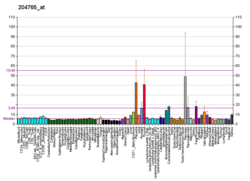ARHGEF5
Rho guanine nucleotide exchange factor 5 is a protein that in humans is encoded by the ARHGEF5 gene.[3][4][5]
Rho GTPases play a fundamental role in numerous cellular processes initiated by extracellular stimuli that work through G protein-coupled receptors. The encoded protein may form a complex with G proteins and stimulate Rho-dependent signals. This protein may be involved in the control of cytoskeletal organization.[5]
References
- ↑ "Human PubMed Reference:".
- ↑ "Mouse PubMed Reference:".
- ↑ Chan AM, McGovern ES, Catalano G, Fleming TP, Miki T (Apr 1994). "Expression cDNA cloning of a novel oncogene with sequence similarity to regulators of small GTP-binding proteins". Oncogene. 9 (4): 1057–63. PMID 8134109.
- ↑ Takai S, Chan AM, Yamada K, Miki T (Oct 1995). "Assignment of the human TIM proto-oncogene to 7q33→q35". Cancer Genet Cytogenet. 83 (1): 87–9. PMID 7656213. doi:10.1016/S0165-4608(95)00017-8.
- 1 2 "Entrez Gene: ARHGEF5 Rho guanine nucleotide exchange factor (GEF) 5".
External links
- Human ARHGEF5 genome location and ARHGEF5 gene details page in the UCSC Genome Browser.
Further reading
- Snyder JT, Worthylake DK, Rossman KL, et al. (2002). "Structural basis for the selective activation of Rho GTPases by Dbl exchange factors.". Nat. Struct. Biol. 9 (6): 468–75. PMID 12006984. doi:10.1038/nsb796.
- Wistow G, Bernstein SL, Wyatt MK, et al. (2002). "Expressed sequence tag analysis of adult human lens for the NEIBank Project: over 2000 non-redundant transcripts, novel genes and splice variants.". Mol. Vis. 8: 171–84. PMID 12107413.
- Strausberg RL, Feingold EA, Grouse LH, et al. (2003). "Generation and initial analysis of more than 15,000 full-length human and mouse cDNA sequences.". Proc. Natl. Acad. Sci. U.S.A. 99 (26): 16899–903. PMC 139241
 . PMID 12477932. doi:10.1073/pnas.242603899.
. PMID 12477932. doi:10.1073/pnas.242603899. - Hillier LW, Fulton RS, Fulton LA, et al. (2003). "The DNA sequence of human chromosome 7.". Nature. 424 (6945): 157–64. PMID 12853948. doi:10.1038/nature01782.
- Ota T, Suzuki Y, Nishikawa T, et al. (2004). "Complete sequencing and characterization of 21,243 full-length human cDNAs.". Nat. Genet. 36 (1): 40–5. PMID 14702039. doi:10.1038/ng1285.
- Gerhard DS, Wagner L, Feingold EA, et al. (2004). "The status, quality, and expansion of the NIH full-length cDNA project: the Mammalian Gene Collection (MGC).". Genome Res. 14 (10B): 2121–7. PMC 528928
 . PMID 15489334. doi:10.1101/gr.2596504.
. PMID 15489334. doi:10.1101/gr.2596504. - Umetsu DT, Dekruyff RH (2005). "Regulation of tolerance in the respiratory tract: TIM-1, hygiene, and the environment.". Ann. N. Y. Acad. Sci. 1029 (1): 88–93. PMID 15681748. doi:10.1196/annals.1309.012.
- Benzinger A, Muster N, Koch HB, et al. (2005). "Targeted proteomic analysis of 14-3-3 sigma, a p53 effector commonly silenced in cancer.". Mol. Cell Proteomics. 4 (6): 785–95. PMID 15778465. doi:10.1074/mcp.M500021-MCP200.
- Zhang Y, Wolf-Yadlin A, Ross PL, et al. (2005). "Time-resolved mass spectrometry of tyrosine phosphorylation sites in the epidermal growth factor receptor signaling network reveals dynamic modules.". Mol. Cell Proteomics. 4 (9): 1240–50. PMID 15951569. doi:10.1074/mcp.M500089-MCP200.
This article is issued from
Wikipedia.
The text is licensed under Creative Commons - Attribution - Sharealike.
Additional terms may apply for the media files.
